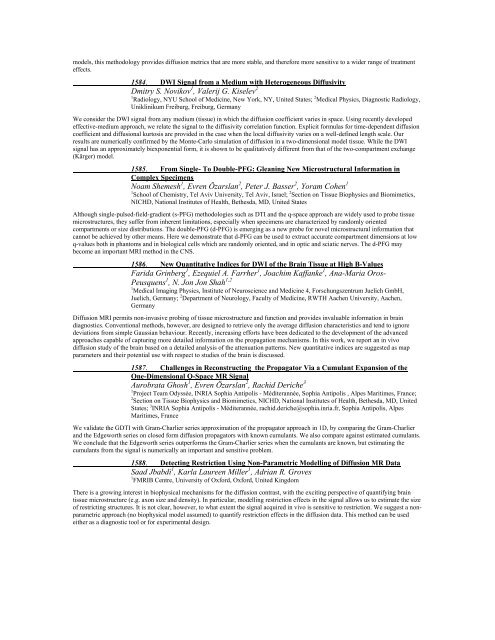Traditional Posters: Diffusion & Perfusion - ismrm
Traditional Posters: Diffusion & Perfusion - ismrm
Traditional Posters: Diffusion & Perfusion - ismrm
Create successful ePaper yourself
Turn your PDF publications into a flip-book with our unique Google optimized e-Paper software.
models, this methodology provides diffusion metrics that are more stable, and therefore more sensitive to a wider range of treatment<br />
effects.<br />
1584. DWI Signal from a Medium with Heterogeneous Diffusivity<br />
Dmitry S. Novikov 1 , Valerij G. Kiselev 2<br />
1 Radiology, NYU School of Medicine, New York, NY, United States; 2 Medical Physics, Diagnostic Radiology,<br />
Uniklinikum Freiburg, Freiburg, Germany<br />
We consider the DWI signal from any medium (tissue) in which the diffusion coefficient varies in space. Using recently developed<br />
effective-medium approach, we relate the signal to the diffusivity correlation function. Explicit formulas for time-dependent diffusion<br />
coefficient and diffusional kurtosis are provided in the case when the local diffusivity varies on a well-defined length scale. Our<br />
results are numerically confirmed by the Monte-Carlo simulation of diffusion in a two-dimensional model tissue. While the DWI<br />
signal has an approximately biexponential form, it is shown to be qualitatively different from that of the two-compartment exchange<br />
(Kärger) model.<br />
1585. From Single- To Double-PFG: Gleaning New Microstructural Information in<br />
Complex Specimens<br />
Noam Shemesh 1 , Evren Özarslan 2 , Peter J. Basser 2 , Yoram Cohen 1<br />
1 School of Chemistry, Tel Aviv University, Tel Aviv, Israel; 2 Section on Tissue Biophysics and Biomimetics,<br />
NICHD, National Institutes of Health, Bethesda, MD, United States<br />
Although single-pulsed-field-gradient (s-PFG) methodologies such as DTI and the q-space approach are widely used to probe tissue<br />
microstructures, they suffer from inherent limitations, especially when specimens are characterized by randomly oriented<br />
compartments or size distributions. The double-PFG (d-PFG) is emerging as a new probe for novel microstructural information that<br />
cannot be achieved by other means. Here we demonstrate that d-PFG can be used to extract accurate compartment dimensions at low<br />
q-values both in phantoms and in biological cells which are randomly oriented, and in optic and sciatic nerves. The d-PFG may<br />
become an important MRI method in the CNS.<br />
1586. New Quantitative Indices for DWI of the Brain Tissue at High B-Values<br />
Farida Grinberg 1 , Ezequiel A. Farrher 1 , Joachim Kaffanke 1 , Ana-Maria Oros-<br />
Peusquens 1 , N. Jon Jon Shah 1,2<br />
1 Medical Imaging Physics, Institute of Neuroscience and Medicine 4, Forschungszentrum Juelich GmbH,<br />
Juelich, Germany; 2 Department of Neurology, Faculty of Medicine, RWTH Aachen University, Aachen,<br />
Germany<br />
<strong>Diffusion</strong> MRI permits non-invasive probing of tissue microstructure and function and provides invaluable information in brain<br />
diagnostics. Conventional methods, however, are designed to retrieve only the average diffusion characteristics and tend to ignore<br />
deviations from simple Gaussian behaviour. Recently, increasing efforts have been dedicated to the development of the advanced<br />
approaches capable of capturing more detailed information on the propagation mechanisms. In this work, we report an in vivo<br />
diffusion study of the brain based on a detailed analysis of the attenuation patterns. New quantitative indices are suggested as map<br />
parameters and their potential use with respect to studies of the brain is discussed.<br />
1587. Challenges in Reconstructing the Propagator Via a Cumulant Expansion of the<br />
One-Dimensional Q-Space MR Signal<br />
Aurobrata Ghosh 1 , Evren Özarslan 2 , Rachid Deriche 3<br />
1 Project Team Odyssée, INRIA Sophia Antipolis - Méditerannée, Sophia Antipolis , Alpes Maritimes, France;<br />
2 Section on Tissue Biophysics and Biomimetics, NICHD, National Institutes of Health, Bethesda, MD, United<br />
States; 3 INRIA Sophia Antipolis - Méditerannée, rachid.deriche@sophia.inria.fr, Sophia Antipolis, Alpes<br />
Maritimes, France<br />
We validate the GDTI with Gram-Charlier series approximation of the propagator approach in 1D, by comparing the Gram-Charlier<br />
and the Edgeworth series on closed form diffusion propagators with known cumulants. We also compare against estimated cumulants.<br />
We conclude that the Edgeworth series outperforms the Gram-Charlier series when the cumulants are known, but estimating the<br />
cumulants from the signal is numerically an important and sensitive problem.<br />
1588. Detecting Restriction Using Non-Parametric Modelling of <strong>Diffusion</strong> MR Data<br />
Saad Jbabdi 1 , Karla Laureen Miller 1 , Adrian R. Groves<br />
1 FMRIB Centre, University of Oxford, Oxford, United Kingdom<br />
There is a growing interest in biophysical mechanisms for the diffusion contrast, with the exciting perspective of quantifying brain<br />
tissue microstructure (e.g. axon size and density). In particular, modelling restriction effects in the signal allows us to estimate the size<br />
of restricting structures. It is not clear, however, to what extent the signal acquired in vivo is sensitive to restriction. We suggest a nonparametric<br />
approach (no biophysical model assumed) to quantify restriction effects in the diffusion data. This method can be used<br />
either as a diagnostic tool or for experimental design.















